ASM Metals HandBook Vol. 17 - Nondestructive Evaluation and Quality Control
Подождите немного. Документ загружается.

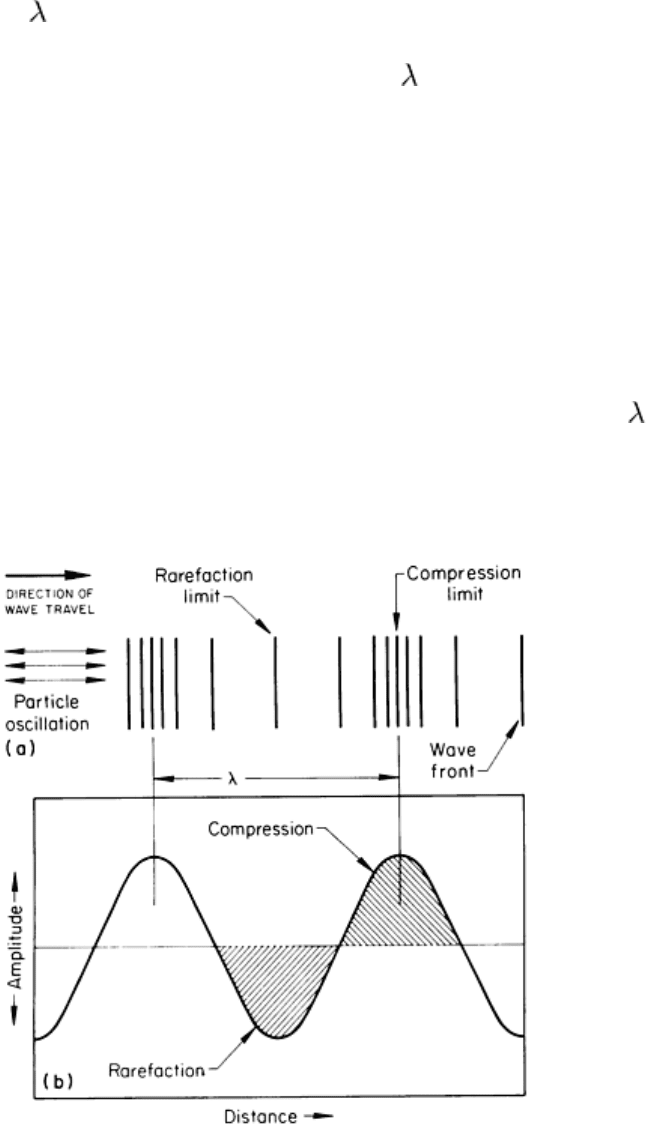
Wave Propagation. Ultrasonic waves (and other sound waves) propagate to some extent in any elastic material. When
the atomic or molecular particles of an elastic material are displaced from their equilibrium positions by any applied
force, internal stress acts to restore the particles to their original positions. Because of the interatomic forces between
adjacent particles of material, a displacement at one point induces displacements at neighboring points and so on, thus
propagating a stress-strain wave. The actual displacement of matter that occurs in ultrasonic waves is extremely small.
The amplitude, vibration mode, and velocity of the waves differ in solids, liquids, and gases because of the large
differences in the mean distance between particles in these forms of matter. These differences influence the forces of
attraction between particles and the elastic behavior of the materials.
The concepts of wavelength, cycle, frequency, amplitude, velocity, and attenuation described in the preceding section
"Analogy With Waves in Water" in this article apply in general to ultrasonic waves and other sound waves. The relation
of velocity to frequency and wavelength is given by:
V = f
(Eq 1)
where V is velocity (in meters per second), f is frequency (in hertz), and is wavelength (in meters per cycle). Other
consistent units of measure can be used for the variables in Eq 1, where convenient.
On the basis of the mode of particle displacement, ultrasonic waves are classified as longitudinal waves, transverse
waves, surface waves, and Lamb waves. These four types of waves are described in the following sections.
Longitudinal waves, sometimes called compression waves, are the type of ultrasonic waves most widely used in the
inspection of materials. These waves travel through materials as a series of alternate compressions and rarefactions in
which the particles transmitting the wave vibrate back and forth in the direction of travel of the waves.
Longitudinal ultrasonic waves and the corresponding particle oscillation and resultant rarefaction and compression are
shown schematically in Fig. 1(a); a plot of amplitude of particle displacement versus distance of wave travel, together
with the resultant rarefaction trough and compression crest, is shown in Fig. 1(b). The distance from one crest to the next
(which equals the distance for one complete cycle of rarefaction and compression) is the wavelength, . The vertical axis
in Fig. 1(b) could represent pressure instead of particle displacement. The horizontal axis could represent time instead of
travel distance because the speed of sound is constant in a given material and because this relation is used in the
measurements made in ultrasonic inspection.
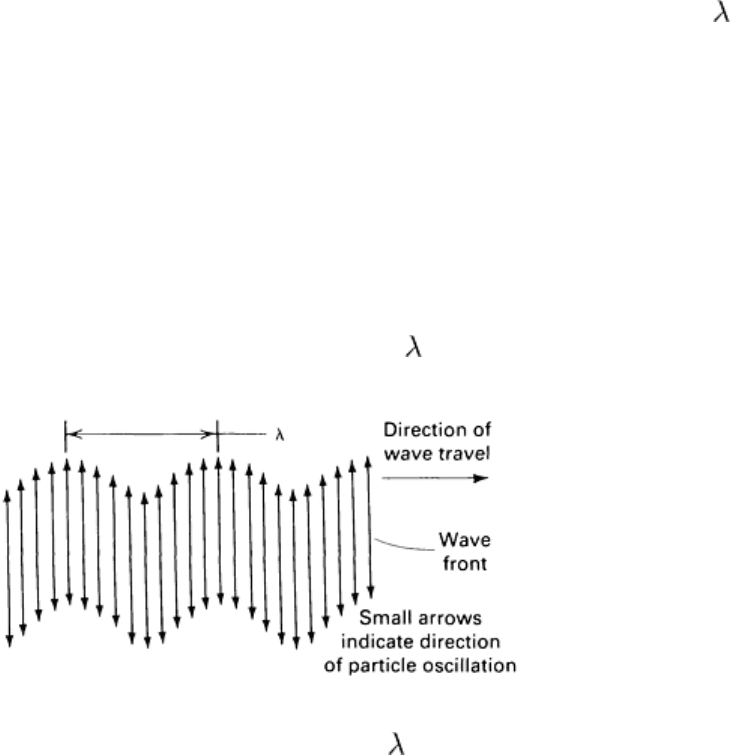
Fig. 1 Schematic of longitudinal ultrasonic waves. (a) Particle oscillation and resultant r
arefaction and
compression. (b) Amplitude of particle displacement versus distance of wave travel. The wavelength,
, is the
distance corresponding to one complete cycle.
Longitudinal ultrasonic waves are readily propagated in liquids and gases as well as in elastic solids. The mean free paths
of the molecules of liquids and gases at a pressure of 1 atm are so short that longitudinal waves can be propagated simply
by the elastic collision of one molecule with the next. The velocity of longitudinal ultrasonic waves is about 6000 m/s
(20,000 ft/s) in steel, 1500 m/s (5000 ft/s) in water, and 330 m/s (1080 ft/s) in air.
Transverse waves (shear waves) are also extensively used in the ultrasonic inspection of materials. Transverse
waves are visualized readily in terms of vibrations of a rope that is shaken rhythmically, in which each particle, rather
than vibrating parallel to the direction of wave motion as in the longitudinal wave, vibrates up and down in a plane
perpendicular to the direction of propagation. A transverse wave is illustrated schematically in Fig. 2, which shows
particle oscillation, wave front, direction of wave travel, and the wavelength, , corresponding to one cycle.
Fig. 2 Schematic of transverse (shear) waves. The wavelength,
, is the distance corresponding to one
complete cycle.
Unlike longitudinal waves, transverse waves cannot be supported by the elastic collision of adjacent molecular or atomic
particles. For the propagation of transverse waves, it is necessary that each particle exhibit a strong force of attraction to
its neighbors so that as a particle moves back and forth it pulls its neighbor with it, thus causing the sound to move
through the material with the velocity associated with transverse waves, which is about 50% of the longitudinal wave
velocity for the same material.
Air and water will not support transverse waves. In gases, the forces of attraction between molecules are so small that
shear waves cannot be transmitted. The same is true of a liquid, unless it is particularly viscous or is present as a very thin
layer.
Surface waves (Rayleigh waves) are another type of ultrasonic wave used in the inspection of materials. These
waves travel along the flat or curved surface of relatively thick solid parts. For the propagation of waves of this type, the
waves must be traveling along an interface bounded on one side by the strong elastic forces of a solid and on the other
side by the practically negligible elastic forces between gas molecules. Surface waves leak energy into liquid couplants
and do not exist for any significant distance along the surface of a solid immersed in a liquid, unless the liquid covers the
solid surface only as a very thin film.
Surface waves are subject to attenuation in a given material, as are longitudinal or transverse waves. They have a velocity
approximately 90% of the transverse wave velocity in the same material. The region within which these waves propagate
with effective energy is not much thicker than about one wavelength beneath the surface of the metal. At this depth, wave
energy is about 4% of the wave energy at the surface, and the amplitude of oscillation decreases sharply to a negligible
value at greater depths.
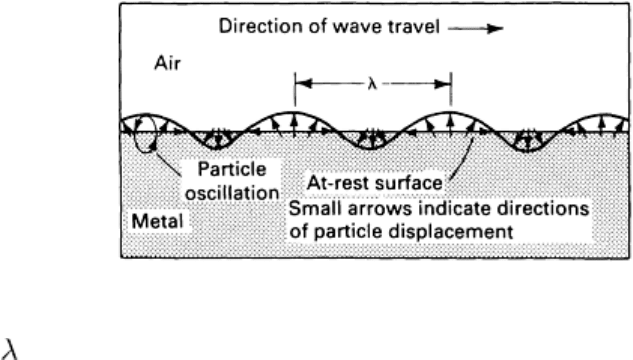
Surface waves follow contoured surfaces. For example, surface waves traveling on the top surface of a metal block are
reflected from a sharp edge, but if the edge is rounded off, the waves continue down the side face and are reflected at the
lower edge, returning to the sending point. Surface waves will travel completely around a cube if all edges of the cube are
rounded off. Surface waves can be used to inspect parts that have complex contours.
In surface waves, particle oscillation generally follows an elliptical orbit, as shown schematically in Fig. 3. The major
axis of the ellipse is perpendicular to the surface along which the waves are traveling. The minor axis is parallel to the
direction of propagation.surface waves can exist in complex forms that are variations of the simplified waveform
illustrated in Fig. 3.
Fig. 3
Diagram of surface (Rayleigh) waves propagating at the surface of a metal along a metal/air interface.
The wavelength, , is the distance corresponding to one complete cycle.
Lamb waves, also known as plate waves, are another type of ultrasonic wave used in the nondestructive inspection of
materials. Lamb waves are propagated in plates (made of composites or metals) only a few wavelengths thick. A Lamb
wave consists of a complex vibration that occurs throughout the thickness of the material. The propagation characteristics
of Lamb waves depend on the density, elastic properties, and structure of the material as well as the thickness of the
testpiece and the frequency. Their behavior in general resembles that observed in the transmission of electromagnetic
waves through waveguides.
There are two basic forms of Lamb waves:
• Symmetrical, or dilatational
• Asymmetrical, or bending
The form is determined by whether the particle motion is symmetrical or asymmetrical with respect to the neutral axis of
the testpiece. Each form is further subdivided into several modes having different velocities, which can be controlled by
the angle at which the waves enter the testpiece. Theoretically, there are an infinite number of specific velocities at which
Lamb waves can travel in a given material. Within a given plate, the specific velocities for Lamb waves are complex
functions of plate thickness and frequency. The specific velocities of Lamb waves are discussed in Ref 1 and 2.
In symmetrical (dilatational) Lamb waves, there is a compressional (longitudinal) particle displacement along the neutral
axis of the plate and an elliptical particle displacement on each surface (Fig. 4a). In asymmetrical (bending) Lamb waves,
there is a shear (transverse) particle displacement along the neutral axis of the plate and an elliptical particle displacement
on each surface (Fig. 4b). The ratio of the major to minor axes of the ellipse is a function of the material in which the
wave is being propagated.
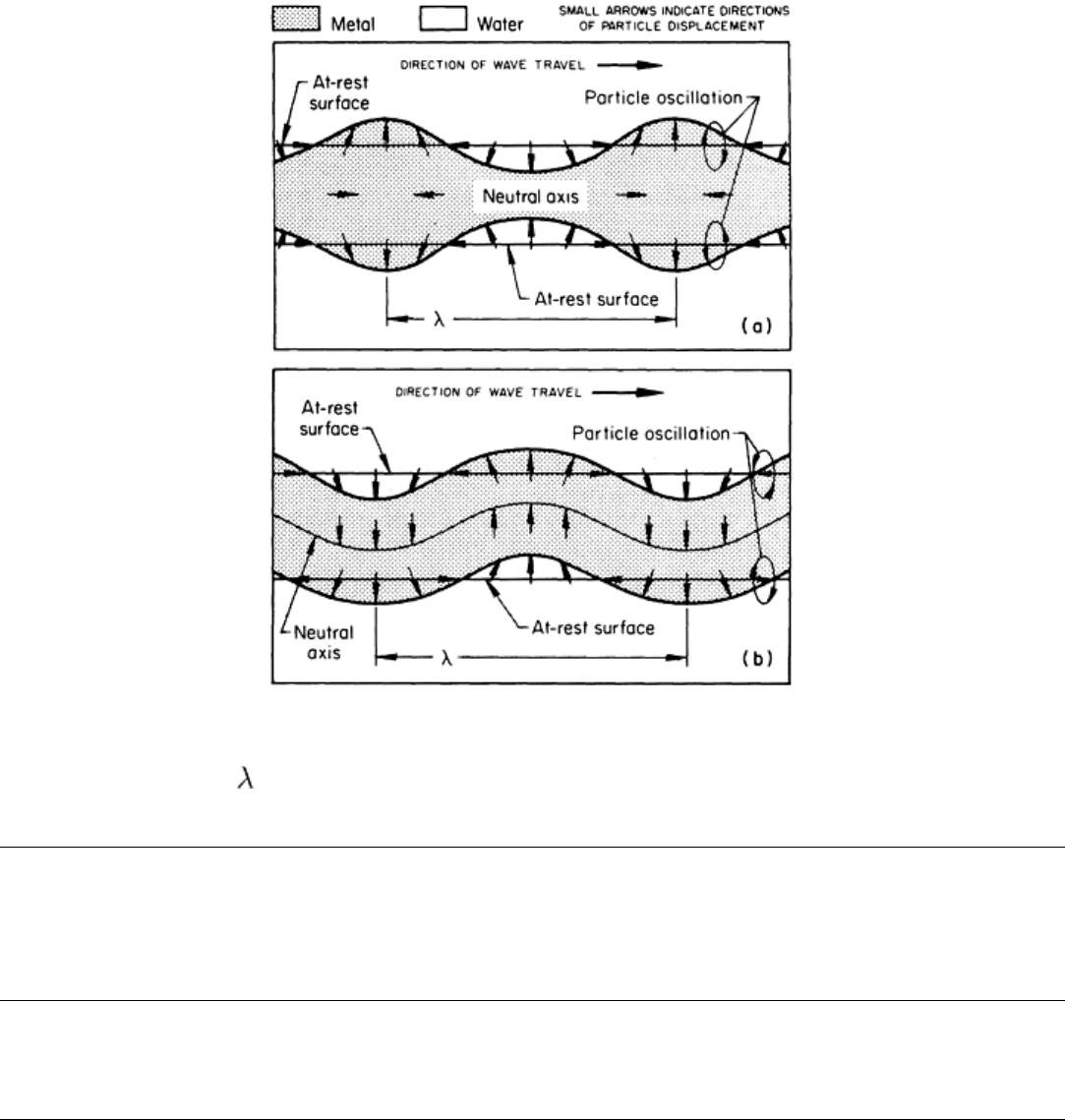
Fig. 4
Diagram of the basic patterns of (a) symmetrical (dilatational) and (b) asymmetrical (bending) Lamb
waves. The wavelength, , is the distance corresponding to one complete cycle.
References cited in this section
1.
A.J. Krautkramer and H. Krautkramer, Ultrasonic Testing of Materials, 1st ed, Springer-Verlag, 1969
2.
D. Ensminger, Ultrasonics, Marcel Dekker, 1973
Ultrasonic Inspection
Revised by Yoseph Bar-Cohen, Douglas Aircraft Company, McDonnell Douglas Corporation; Ajit K. Mal, University of California, Los
Angeles; and the ASM Committee on Ultrasonic Inspection
*
Major Variables in Ultrasonic Inspection
The major variables that must be considered in ultrasonic inspection include both the characteristics of the ultrasonic
waves used and the characteristics of the parts being inspected. Equipment type and capability interact with these
variables; often, different types of equipment must be selected to accomplish different inspection objectives.
The frequency of the ultrasonic waves used affects inspection capability in several ways. Generally, a compromise
must be made between favorable and adverse effects to achieve an optimum balance and to overcome the limitations
imposed by equipment and test material.
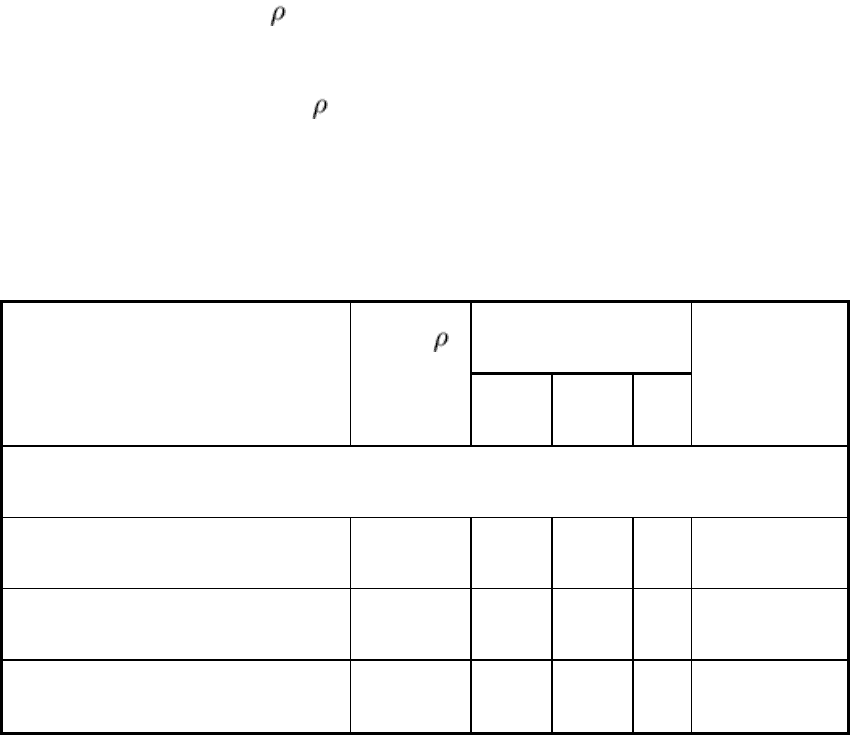
Sensitivity, or the ability of an ultrasonic inspection system to detect a very small discontinuity, is generally increased by
using relatively high frequencies (short wavelengths). Resolution, or the ability of the system to give simultaneous,
separate indications from discontinuities that are close together both in depth below the front surface of the testpiece and
in lateral position, is directly proportional to frequency band-width and inversely related to pulse length. Resolution
generally improves with an increase of frequency.
Penetration, or the maximum depth (range) in a material from which useful indications can be detected, is reduced by the
use of high frequencies. This effect is most pronounced in the inspection of metal that has coarse grain structure or minute
inhomogeneities, because of the resultant scattering of the ultrasonic waves; it is of little consequence in the inspection of
fine-grain, homogeneous metal.
Beam spread, or the divergence of an ultrasonic beam from the central axis of the beam, is also affected by frequency. As
frequency decreases, the shape of an ultrasonic beam increasingly departs from the ideal of zero beam spread. This
characteristic is so pronounced as to be observed at almost all frequencies used in inspection. Other factors, such as the
transducer (search unit) diameter and the use of focusing equipment, also affect beam spread; these are discussed in
greater detail in the sections "Beam Spreading" and "Acoustic Lenses" in this article. Sensitivity, resolution, penetration,
and beam spread are largely determined by the selection of the transducer and are only slightly modified by changes in
other test variables.
Acoustic Impedance. When ultrasonic waves traveling through one medium impinge on the boundary of a second
medium, a portion of the incident acoustic energy is reflected back from the boundary while the remaining energy is
transmitted into the second medium. The characteristic that determines the amount of reflection is the acoustic impedance
of the two materials on either side of the boundary. If the impedances of the two materials are equal, there will be no
reflection; if the impedances differ greatly (as between a metal and air, for example), there will be virtually complete
reflection. This characteristic is used in the ultrasonic inspection of metals to calculate the amounts of energy reflected
and transmitted at impedance discontinuities and to aid in the selection of suitable materials for the effective transfer of
acoustic energy between components in ultrasonic inspection systems.
The acoustic impedance for a longitudinal wave, Z
l
, given in grams per square centimeter-second, is defined as the
product of material density, , given in grams per cubic centimeter, and longitudinal wave velocity, V
l
, given in
centimeters per second:
Z
l
= V
l
(Eq 2)
The acoustic properties of several metals and nonmetals are listed in Table 1. The acoustic properties of metals and alloys
are influenced by variations in structure and metallurgical condition. Therefore, for a given testpiece the properties may
differ somewhat from the values listed in Table 1.
Table 1 Acoustic properties of several metals and nonmetals
Sonic velocities, 10
5
cm/s
Material
Density ( ),
g/cm
3
V
l
(a)
V
t
(b)
V
s
(c)
Acoustic
impedance (Z
1
)
(d)
,
10
6
g/cm
2
· s
Ferrous metals
Carbon steel, annealed 7.85 5.94 3.24 3.0
4.66
Alloy steel
Annealed
7.86 5.95 3.26 3.0
4.68

Hardened
7.8 5.90 3.23 . . .
4.6
Cast iron 6.95-7.35 3.5-5.6 2.2-3.2 . . .
2.5-4.0
52100 steel
Annealed
7.83 5.99 3.27 . . .
4.69
Hardened
7.8 5.89 3.20 . . .
4.6
D6 tool steel
Annealed
7.7 6.14 3.31 . . .
4.7
Hardened
7.7 6.01 3.22 . . .
4.6
Stainless steels
Type 302
7.9 5.66 3.12 3.12
4.47
Type 304L
7.9 5.64 3.07 . . .
4.46
Type 347
7.91 5.74 3.10 2.8
4.54
Type 410
7.67 5.39 2.99 2.16
4.13
Type 430
7.7 6.01 3.36 . . .
4.63
Nonferrous metals
Aluminum 1100-O 2.71 6.35 3.10 2.90
1.72
Aluminum alloy 2117-T4 2.80 6.25 3.10 2.79
1.75
Beryllium 1.85 12.80 8.71 7.87
2.37
Copper 110 8.9 4.70 2.26 1.93
4.18
Copper alloys

260 (cartridge brass, 70%)
8.53 3.83 2.05 1.86
3.27
464 to 467 (naval brass)
8.41 4.43 2.12 1.95
3.73
510 (phosphor bronze, 5% A)
8.86 3.53 2.23 2.01
3.12
752 (nickel silver 65-18)
8.75 4.62 2.32 1.69
4.04
Lead
Pure
11.34 2.16 0.70 0.64
2.45
Hard (94Pb-6Sb)
10.88 2.16 0.81 0.73
2.35
Magnesium alloy M1A 1.76 5.74 3.10 2.87
1.01
Mercury, liquid 13.55 1.45 . . . . . .
1.95
Molybdenum 10.2 6.25 3.35 3.11
6.38
Nickel
Pure
8.8 5.63 2.96 2.64
4.95
Inconel
8.5 5.82 3.02 2.79
4.95
Inconel X-750
8.3 5.94 3.12 . . .
4.93
Monel
8.83 5.35 2.72 2.46
4.72
Titanium, commercially pure 4.5 6.10 3.12 2.79
2.75
Tungsten 19.25 5.18 2.87 2.65
9.98
Nonmetals
Air
(e)
0.00129 0.331 . . . . . .
0.00004
Ethylene glycol 1.11 1.66 . . . . . .
0.18

Glass
Plate
2.5 5.77 3.43 3.14
1.44
Pyrex
2.23 5.57 3.44 3.13
1.24
Glycerin 1.26 1.92 . . . . . .
0.24
Oil
Machine (SAE 20)
0.87 1.74 . . . . . .
0.150
Transformer
0.92 1.38 . . . . . .
0.127
Paraffin wax 0.9 2.2 . . . . . .
0.2
Plastics
Methylmethacrylate (Lucite, Plexiglas)
1.18 2.67 1.12 1.13
0.32
Polyamide (nylon)
1.0-1.2 1.8-2.2 . . . . . .
0.18-0.27
Polytetrafluoroethylene (Teflon) 2.2 1.35 . . . . . .
0.30
Quartz, natural 2.65 5.73 . . . . . .
1.52
Rubber, vulcanized 1.1-1.6 2.3 . . . . . .
0.25-0.37
Tungsten carbide 10-15 6.66 3.98 . . .
6.7-9.9
Water
Liquid
(f)
1.0 1.49 . . . . . .
0.149
Ice
(g)
0.9 3.98 1.99 . . . 0.36
(a)
Longitudinal (compression) waves.
(b)
Transverse (shear) waves.

(c)
Surface waves.
(d)
For longitudinal waves Z
1
= V
1
.
(e)
At standard temperature and pressure.
(f)
At 4 °C (39 °F).
(g)
At 0 °C (32 °F)
The percentage of incident energy reflected from the interface between two materials depends on the ratio of acoustic
impedances (Z
2
/Z
1
) and the angle of incidence. When the angle of incidence is 0° (normal incidence), the reflection
coefficient, R, which is the ratio of reflected beam intensity, I
r
, to incident beam intensity, I
i
, is given by:
R = I
r
/I
i
= [(Z
2
- Z
1
)/(Z
2
+ Z
1
)]
2
= [(r - 1)/(r + 1)]
2
(Eq 3)
where Z
1
is the acoustic impedance of medium 1, Z
2
is the acoustic impedance of medium 2, and r equals Z
2
/Z
1
and is the
impedance ratio, or mismatch factor. With T designating the transmission coefficient, R + T = 100%, because all the
energy is either reflected or transmitted, and T is simply obtained from this relation.
The transmission coefficient, T, can also be calculated as the ratio of the intensity of the transmitted beam, I
t
, to that of the
incident beam, I
i
, from:
T = I
t
/I
i
= 4Z
2
Z
1
/(Z
2
+ Z
1
)
2
= 4r/(r + 1)
2
(Eq 4)
When a longitudinal ultrasonic wave in water (medium 1) is incident at right angles to the surface of an aluminum alloy
1100 testpiece (medium 2), the percentages of acoustic energy reflected and transmitted are calculated as shown below
(the calculations are based on data from Table 1):
Impedance ratio (r) = Z
2
/Z
1
= 1.72/0.149 = 11.54
Reflection coefficient (R) = [(r - 1)/(r + 1)]
2
= (10.54/12.54)
2
= 0.71 = 71%
Transmission coefficient (T) = 1 - R = 0.29 = 29%
The same values are obtained for R and T when medium 1 is the aluminum alloy and medium 2 is water. For any pair of
materials, reversing the order of the materials does not change the values of R and T.
Angle of Incidence. Only when an ultrasonic wave is incident at right angles on an interface between two materials
(normal incidence; that is, angle of incidence = 0°) do transmission and reflection occur at the interface without any
change in beam direction. At any other angle of incidence, the phenomena of mode conversion (a change in the nature of
the wave motion) and refraction (a change in direction of wave propagation) must be considered. These phenomena may
affect the entire beam or only a portion of the beam, and the sum total of the changes that occur at the interface depends
on the angle of incidence and the velocity of the ultrasonic waves leaving the point of impingement on the interface. All
possible ultrasonic waves leaving this point are shown for an incident longitudinal ultrasonic wave in Fig. 5. Not all the
waves shown in Fig. 5 will be produced in any specific instance of oblique impingement of an ultrasonic wave on the
interface between two materials. The waves that propagate in a given instance depend on the ability of a waveform to
exist in a given material, the angle of incidence of the initial beam, and the velocities of the waveforms in both materials.
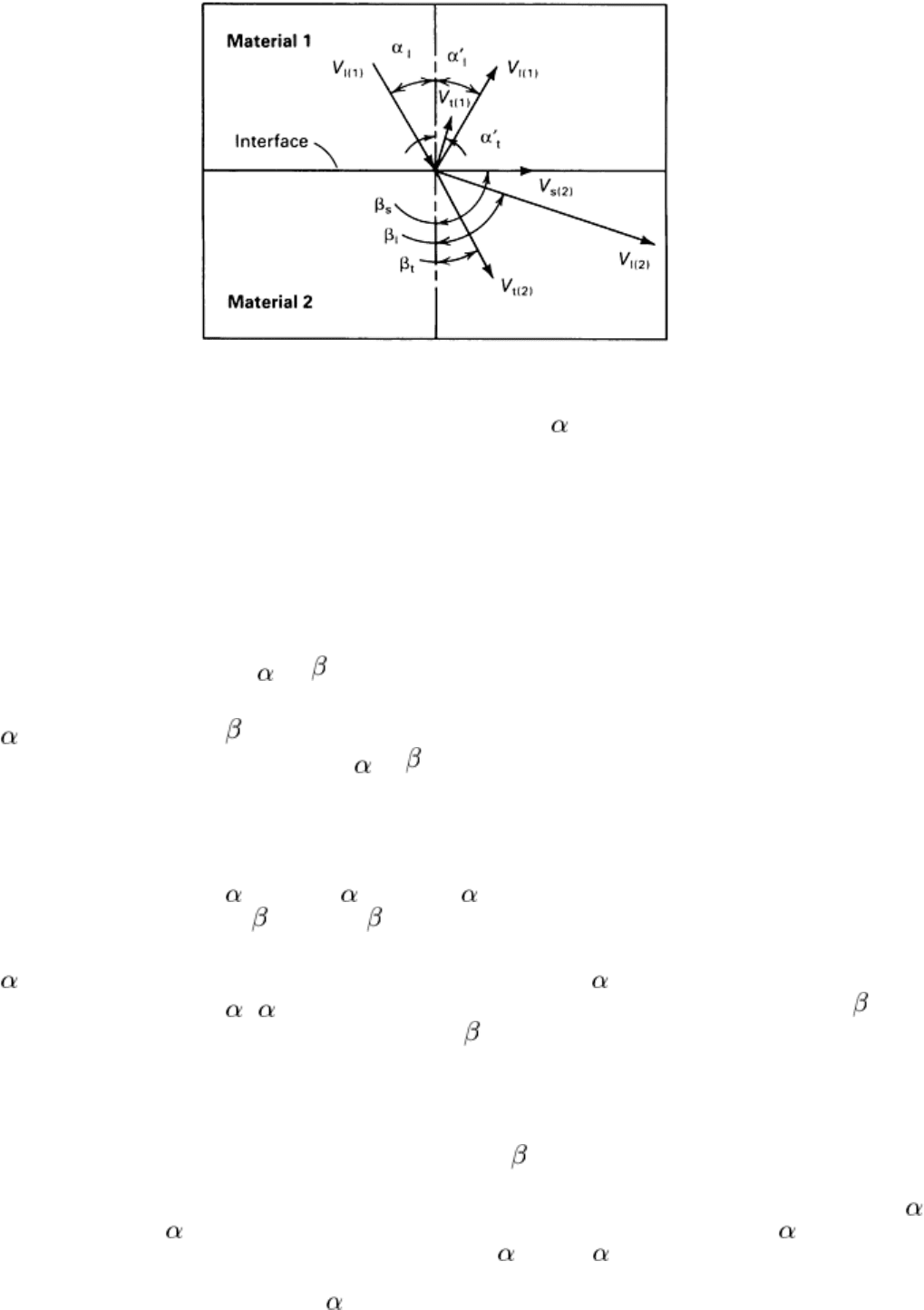
Fig. 5
Diagram showing relationship (by vectors) of all possible reflected and refracted waves to an incident
longitudinal wave of velocity V
l(1)
impinging on an interface at angle
l
relative to normal to the interface.
See
text for explanation of vectors.
The general law that describes wave behavior at an interface is known as Snell's law. Although originally derived for light
waves, Snell's law applies to acoustic waves (including ultrasound) and to many other types of waves. According to
Snell's law, the ratio of the sine of the angle of incidence to the sine of the angle of reflection or refraction equals the ratio
of the corresponding wave velocities. Snell's law applies even if mode conversion takes place. Mathematically, Snell's
law can be expressed as:
sin /sin = V
1
/V
2
(Eq 5)
where is the angle of incidence, is the angle of reflection or refraction, and V
1
, and V
2
are the respective velocities of
the incident and reflected or refracted waves. Both and are measured from a line normal to the interface.
Equation 6 is the general relationship applying to reflection and refraction, taking into account all possible effects of
mode conversion for an incident longitudinal ultrasonic wave, as shown in Fig. 5:
sin
l
/V
l(1)
= sin '
l
/V
l(1)
= sin '
t
/V
t(1)
sin
l
/V
l(2)
= sin
t
/V
t(2)
(Eq 6)
where
l
is the angle of incidence for incident longitudinal wave in material 1, '
l
is the angle of reflection for reflected
longitudinal wave in material 1 =
l
, '
t
is the angle of reflection for reflected transverse wave in material 1,
l
is the
angle of refraction for refracted longitudinal wave in material 2,
t
is the angle of refraction for refracted transverse wave
in material 2, V
l(1)
is the velocity of incident longitudinal wave in material 1 = velocity of reflected longitudinal wave in
material 1, V
t(1)
is the velocity of reflected transverse wave in material 1, V
l(2)
is the velocity of refracted longitudinal wave
in material 2, andV
t(2)
is the velocity of refracted transverse wave in material 2.
For quantities that are shown in Fig. 5 but do not appear in Eq 6,
s
is the angle of refraction for refracted surface
(Rayleigh) wave in material 2 = 90°, and V
s(2)
is the velocity of refracted surface (Rayleigh) wave in material 2. Equation
6 can apply to similar relationships for an incident transverse (instead of longitudinal) wave by substituting the term sin
t
/V
t(1)
for the first term, sin
l
/V
l(1)
. Correspondingly, in Fig. 5, the incident longitudinal wave at angle
l
, (with velocity
V
l(1)
in material 1) would be replaced by an incident transverse angle
t
equal to '
t
(with velocity V
t(1)
).
Critical Angles. If the angle of incidence (
l
, Fig. 5) is small, sound waves propagating in a given medium may
undergo mode conversion at a boundary, resulting in the simultaneous propagation of longitudinal and transverse (shear)
